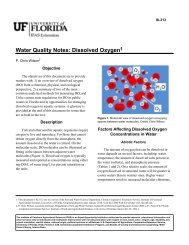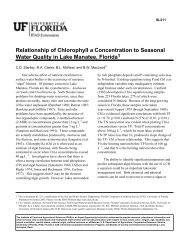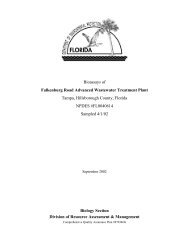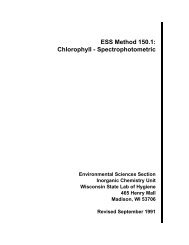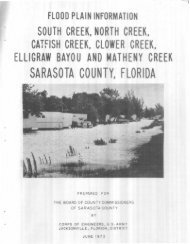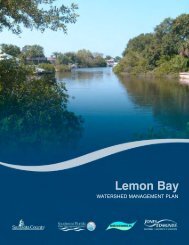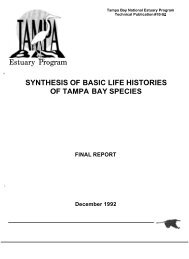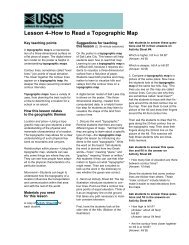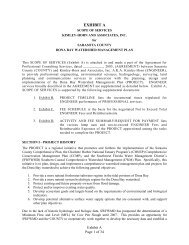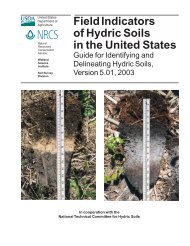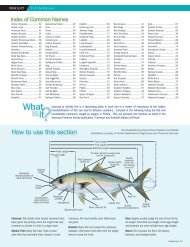CLIENT NAME - Sarasota.WaterAtlas.org
CLIENT NAME - Sarasota.WaterAtlas.org
CLIENT NAME - Sarasota.WaterAtlas.org
Create successful ePaper yourself
Turn your PDF publications into a flip-book with our unique Google optimized e-Paper software.
just over 1 mgd in order to meet a blending ratio of approximately 5:1, which will maintainTDS concentrations below 500 mg/L. Figure 2.9 indicates that the historical monthlyaverage production at the University WTF can vary from 0 to 2 mgd depending on systemneeds. An average daily flow of 1.1 mgd has been produced throughout the past 8 years.Purchased water from Manatee County is scheduled to decline gradually until 2025, atwhich time the contract will expire. At that time, the County will not be able to utilize thiswater source unless another treatment method is employed to decrease TDSconcentrations.2.3.3.1 Process DescriptionThe University Wellfield and WTF site are shown in Figure 2.10. Wells are located alongUniversity Parkway starting at the WTF site and extending to the east. Figure 2.11 presentsa process flow schematic of the University WTF. The facility’s treatment elements includegroundwater pumping, degasification, disinfection, and treated water storage and delivery.Figure 2.10 also shows the locations of chemical feed points. Like all other County WTFs,University utilizes free chlorine (in the form of sodium hypochlorite) for primary disinfectionand adds ammonia to produce chloramines for residual disinfection. Treated water from theUniversity WTF is stored in an onsite ground storage tank and is pumped to the northernand central portions of the County, supplemented by water received from Manatee County.A description of the process train is described in the following sections.2.3.3.1.1 Groundwater PumpingThe University Wellfield has 7 active permitted wells. Each well is equipped to withdraw 500gpm, and typically three wells are operated at one time to utilize some wells while othersrest and to equalize production from each well. The configurations are rotated on a regularbasis (approximately once per month). Production wells range in their water quality pumphorsepower. A rotation schedule has been developed to optimize the wellfield operationand to avoid stressing particular areas of the wellfield. A chloride trigger level of 70 mg/Lhas been established for all University wells to control the effects of withdrawals and toallow for proper resting times for each well. All wells have been regularly maintained, andwithin the past six years all but one have been upgraded with new pumps and motors andhave been pulled for cleaning. Further information regarding the University Wellfield isprovided in Appendix E.Raw water is pumped from the wells directly to the degasification system.FINAL - August 31, 2005 34H:\Client\SAR Co_SAR\6873C00 WATER SUPPLY MASTER PLAN UPDATE\Deliverables\TM 2 - Water System Assets\Final\TM2 Final.doc



